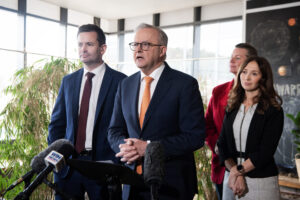Australia’s health system needs intensive care, and so does the tax system that funds it.
Unless the state and federal governments can agree to make big structural changes to the way they collect revenue and spend it on health, then millions more people will die sooner than they need to, live in more pain than is medically necessary and waste years of their lives navigating a broken system rather than doing something far more productive — like working, caring for their kids or simply gardening.
The problem is that we have left the problem to the state health ministers to negotiate solutions with the federal health minister and they are stuck in a zero-sum game.
In the current negotiations, every dollar gained by one state either comes at another’s expense or adds to the Commonwealth deficit.
The obvious solution is to find more revenue, but that’s usually a conversation for treasurers, not health ministers.
Trying to fix our public health system without talking about how to collect more revenue is like trying to cure heart disease while ignoring the need for better diet and exercise.
Systemic problems respond best to systemic solutions. And luckily there is a simple solution to the health ministers’ woes.
But before prescribing the cure, let’s first accurately diagnose the problem.
The states’ major source of revenue from the Commonwealth comes from the GST.
When John Howard and Peter Costello proposed the GST, they roped in state premiers to help sell the idea by promising that all of proceeds from the GST would flow to states to fund services such as health and education.
The problem for today’s state leaders, however, is that even though Costello promised the GST would be a “growth tax”, in reality GST revenue has lagged behind the growth in population and the economy for decades.
When the GST was first introduced, it was expected to grow with GDP, but in reality its revenue has grown more slowly than the economy for decades. As a result, the states are being short-changed.
Research by the Australia Institute shows that the states have missed out on about $231 billion since the turn of the century. This year alone, they will be short about $26 billion thanks to the failure of the GST to live up to Costello’s promise.
Which brings me back to the futility of health ministers trying to dig their way out of a hole.
Neither population growth, population ageing, nor public expectations for timely, high-quality care are likely to disappear any time soon.
So once the state and territory health ministers admit that the GST is not going to fix itself, they need to jointly push for new revenue, as they did in the 1990s.
The most obvious, but least helpful, solution is to simply increase the GST from 10 per cent to 11 or 12 per cent. But the GST is already a regressive tax riddled with carve-outs and exemptions that favour the wealthy, such as exemptions for private school fees and salary-sacrificed cars.
Similarly, in the middle of a cost-of-living crisis, with the RBA struggling to control prices, it’s the worst time to use tax policy to raise consumer prices further.
But there is a simple solution, the federal government could impose a simple tax on gas exported from Commonwealth waters and give the money raised to the states and territories.
The result would be at least $10 billion a year from a modest tax, all of which could be given straight to the states, mostly paid by foreign gas companies. Talk about a win-win.
If we as a nation are serious about fixing Australia’s healthcare system, we can’t leave it to state and territory health ministers to fight with each other – and the Commonwealth – in a zero-sum game.
If a growing and ageing population is to have timely access the latest diagnostic techniques, drugs and dental care, we are going to need to spend more money on health.
Rather than our elected representatives fighting each other over which Australians should miss out on medicine, they should join together to fight the fight the gas industry instead.
Like a needle full of anesthetic, it might sting for a minute but it will save us a lot of pain down the track.
Between the Lines Newsletter
The biggest stories and the best analysis from the team at the Australia Institute, delivered to your inbox every fortnight.
You might also like
Tasmania can afford a new stadium. Here’s how.
The Macquarie Point stadium proposal is controversial. It’s also painfully expensive.
Federal reform to GST would deliver significant revenue to Tasmania and other states
Australia Institute research shows simple reforms to the GST would deliver a much-needed budget boost to Tasmania.
Why we need a tax on private schools
It is odd that many who talk about wanting more tax revenue to come from the GST would balk at the easiest services to broaden it to like private schools and private health insurance.




